5 Essential Google Analytics Reports to Revolutionize Your Marketing Strategy
Utilizing the capabilities of Google Analytics 4 (GA4) is imperative for making data-driven decisions and developing marketing strategies that resonate with audience behavior. While newcomers might find the GA4 interface and terminology overwhelming, this should not deter you. Acquiring a robust understanding of GA4 can reveal insights that significantly enhance your grasp of customer interactions. Once you familiarize yourself with its functionalities and data, GA4 will provide priceless insights about your customer base, enabling you to refine your marketing efforts. Let’s explore five critical GA4 reports that can dramatically improve your marketing strategies.
1. Traffic Acquisition Report: Discover the Key Sources Driving Traffic to Your Website
Have you ever wondered where your website traffic originates? The Traffic Acquisition report is your gateway to uncovering this critical information. This insightful report breaks down the various channels that attract visitors to your site, helping you identify crucial marketing avenues—such as organic search, paid advertising, social media, and referrals. By examining these channels, you will gain a clearer understanding of where your audience comes from, allowing you to concentrate your marketing efforts in the most effective areas.
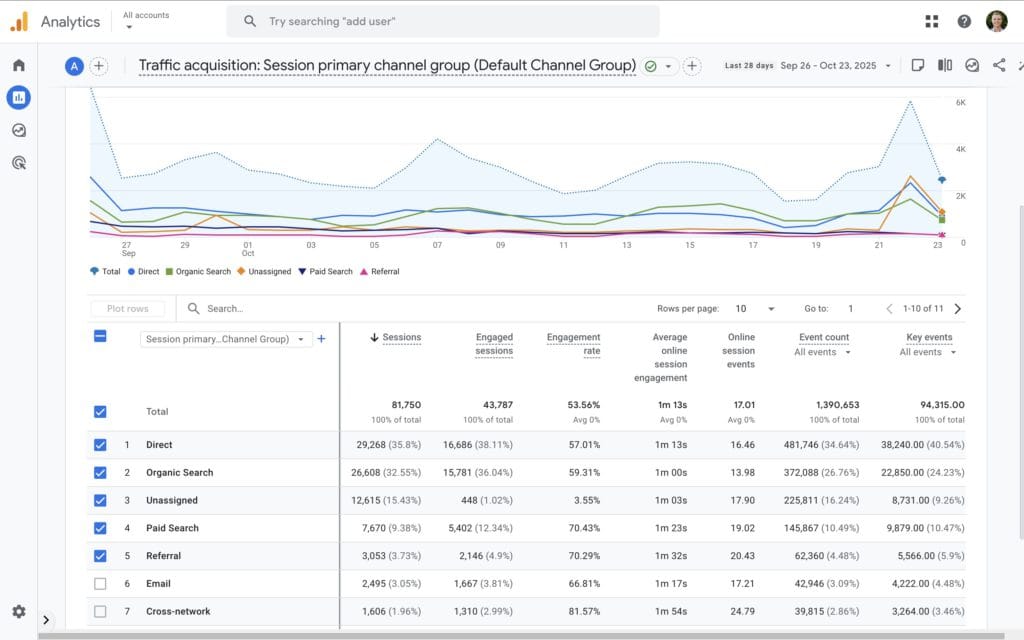
Strategies for Effectively Utilizing the Traffic Acquisition Report:
- Identify Your Top-Performing Channels: Evaluate which platforms are driving the most visitors to your site. If you discover that organic search is leading in traffic, consider boosting your investment in SEO efforts to capitalize on this success.
- Assess Traffic Quality: Go beyond just the volume; analyze metrics like sessions per user and average engagement time to gain deeper insights into visitor interest and commitment.
- Optimize Your Marketing Budget: Allocate your budget intelligently to channels that not only attract visitors but also foster engagement and encourage repeat visits.
By gaining an understanding of your audience’s origins, you can realign your marketing focus to emphasize the channels that yield the most positive outcomes. The report automatically illustrates various pathways users take to access your website, but you can further enhance its effectiveness by tagging your inbound marketing campaigns. This approach is particularly vital when disseminating newsletters or executing advertising campaigns aimed at driving traffic to your site.
Utilizing Campaign Tagging URLs for Enhanced Google Analytics Tracking
Campaign-tagged URLs are specially crafted links to your website that include additional tracking information, known as query parameters, which empower Google Analytics to monitor your marketing efforts with greater precision. By appending these parameters to your URLs, you unlock detailed insights into how visitors land on your site, providing information that transcends standard reports.
Understanding the Role of Campaign Tagging URLs:
- Track Specific Marketing Campaigns: These URLs allow you to pinpoint which particular marketing campaigns are effectively driving traffic to your website.
- Clarify Your Traffic Sources: Understand where your visitors are coming from, whether through a newsletter, a social media post, or a paid advertisement.
- Evaluate Campaign Effectiveness: By analyzing the data derived from tagged URLs, you can identify your most successful campaigns and adjust your strategy as needed.
How Campaign Tagging URLs Enhance Acquisition Reports:
Google Analytics generally categorizes traffic sources into organic search, direct, referral, and organic social. While this categorization provides a foundational understanding, it lacks the depth necessary to derive insights into specific campaigns or links.
Implementing Campaign Tagging in Your URLs:
To effectively utilize campaign-tagged URLs, you must add specific parameters to your inbound links. The crucial parameters include:
- utm_source – identifies the source of your traffic, such as a newsletter, Facebook, or Google.
- utm_medium – specifies the marketing medium, whether it be email, social media, or cost-per-click (CPC).
- utm_campaign – denotes the specific campaign name, like ‘spring sale’ or ‘product launch’.
- utm_term (optional) – primarily used for paid search campaigns to identify specific keywords.
- utm_content (optional) – differentiates similar content or links within the same advertisement or campaign.
For instance, here is a Tagged URL:
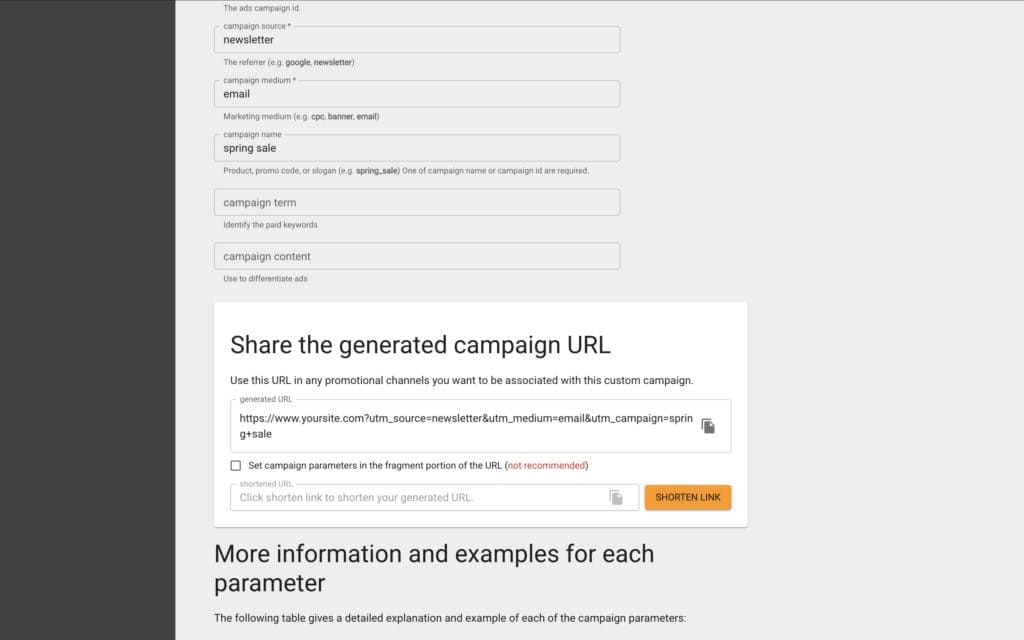
When a user clicks on this link, Google Analytics captures the parameters, allowing you to ascertain that the visitor arrived from your “spring sale” campaign through an email newsletter. By adjusting your inbound links with campaign tags, you can accurately track how users are discovering your website.
In addition to crafting campaign-tagged URLs, linking your Google Ads account with Google Analytics can also provide significant advantages. You can view an instructional video to guide you through this process:
2. Engagement Reports: Deepen Your Understanding of User Interaction on Your Website
Attracting visitors to your site is merely one aspect of the equation. The Engagement Reports deliver crucial insights into what actions visitors take once they arrive. Do they linger and explore, or do they leave promptly? Which pages capture their interest?
Within the Engagement section, the Pages and Screens report outlines all the pages users have engaged with on your website. This report enables you to identify your most and least engaging content. Key metrics to monitor include:
- Views: The total number of times your pages have been accessed, helping you quickly pinpoint content that resonates strongly with users.
- Views Per Active User: This metric aids you in understanding which content users revisit, indicating a high level of interest or value.
- Key Events: Track actions on specific pages, such as purchases, sign-ups, or other conversions. Setting up key events allows you to evaluate how effectively particular pages drive user actions and align with your business objectives.
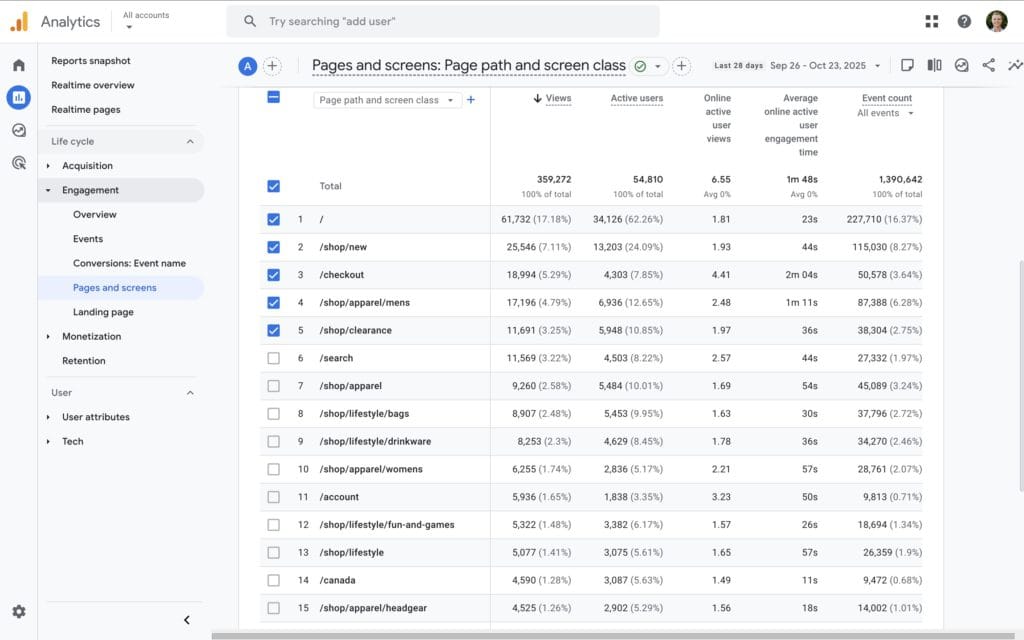
Utilize These Insights to Enhance Your Website:
- Enhance High-Performing Content: If certain blog posts or product pages generate significant engagement, consider creating additional similar content to sustain that interest.
- Revamp Low-Engagement Pages: Identify pages with high bounce rates and implement strategic changes to boost engagement, such as clearer calls to action or more captivating visuals.
- Personalize User Experience: Ensure that navigation is intuitive and content is relevant to encourage visitors to explore your website for longer periods.
Focusing on user engagement is paramount; your objective should not solely be increasing page views but also fostering meaningful connections that convert visitors into leads and customers for your business.
3. Funnel Exploration Report: Strategically Map and Optimize User Journeys
Understanding how users navigate through your website is crucial for improving conversion rates. The Funnel Exploration report in GA4 enables you to visualize the steps users take to achieve specific goals, such as completing a purchase or signing up for a newsletter. This report helps identify where users drop off in the conversion process, providing insights for optimizing each stage to elevate the user experience.
Steps to Create a Funnel Exploration Report in GA4:
Step 1: Set Up the Report
- Navigate to the ‘Explore’ section.
- Click ‘Blank’ to initiate a new report.
- Select ‘Funnel Exploration’ from the dropdown menu under ‘Technique’.
Step 2: Define Your Funnel Steps
- Click the pencil icon next to ‘Steps’ to outline your funnel.
- Add a step for each stage in your user journey and assign it a clear name (e.g., ‘Visited Homepage’, ‘Viewed Product’, ‘Added to Cart’, ‘Completed Purchase’).
- For each step, select the event or page view that corresponds to that action.
For example:
- Visited Homepage: Event name equals ‘page_view’ where page path equals ‘/’.
- Viewed Product: Event name equals ‘view_item’.
- Added to Cart: Event name equals ‘add_to_cart’.
- Completed Purchase: Event name equals ‘purchase’.
- After defining all steps, click ‘Apply’.
Step 3: Customize Your Funnel (Optional)
- Decide whether you want an ‘Open Funnel,’ allowing users to enter at any step, or a ‘Closed Funnel,’ where users must begin at the first step.
- Set an optional timeframe for how long users have to complete the funnel.
- Add filters to focus on specific user criteria if necessary.
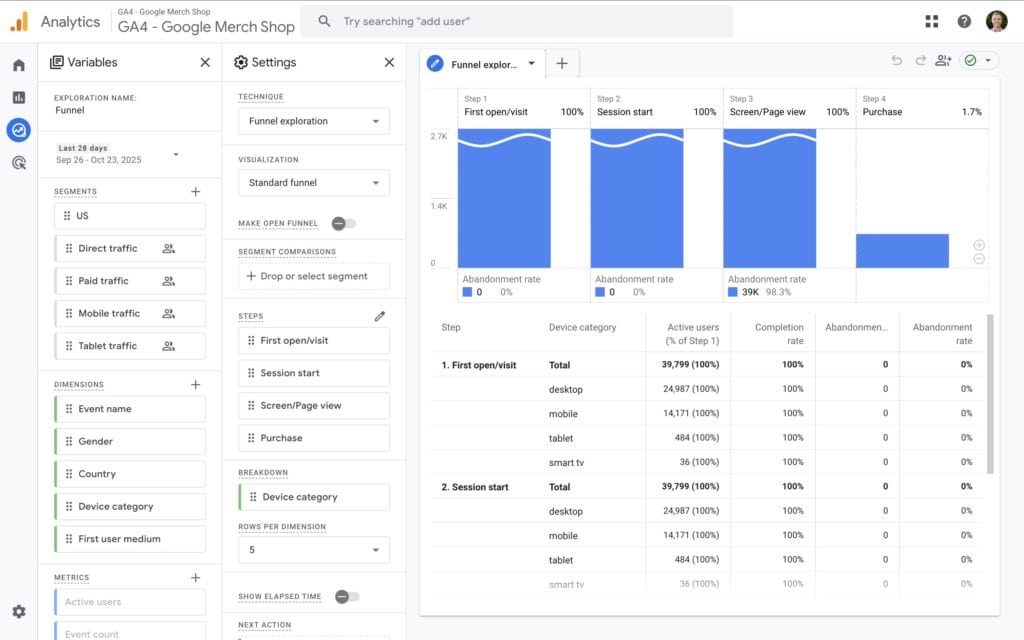
Maximize the Benefits of This Report By:
- Optimizing Conversion Steps: Evaluate each funnel stage to uncover areas for enhancement. If a significant number of users drop off during a specific step, consider simplifying the process or providing additional guidance.
- Enhancing User Experience: Leverage insights from the funnel report to create a more intuitive user journey. This may involve redesigning pages, improving load speeds, or refining calls to action.
- Testing and Iterating: Conduct A/B tests across funnel stages to identify which changes lead to higher conversion rates. Ongoing testing is essential for refining the process over time.
- Personalizing Content: Tailor the user experience based on segment behavior. For instance, if mobile users drop off at a particular point, optimize that step for mobile devices.
Utilizing the Funnel Exploration report enables you to create a more streamlined and effective path to conversion. By recognizing and addressing weaknesses within your funnels, you can refine the process and effectively direct users towards your desired outcomes.
4. Demographic Details Report: Gain In-Depth Insights About Your Audience
The Demographic Details report provides invaluable insights regarding your audience’s age, gender, location, and interests. This information is critical for customizing your content and campaigns to better resonate with your target audience, ultimately driving increased engagement and conversions.
Key Focus Areas in the Demographic Report:
- Age and Gender Analysis: Discover the age ranges and gender distribution of your audience to effectively tailor your messaging.
- Geographic Distribution: Identify user locations to enhance regional marketing efforts and time your campaigns more strategically.
- Interests and Affinity Categories: Understand your users’ interests beyond your website to create content that captivates and engages them.
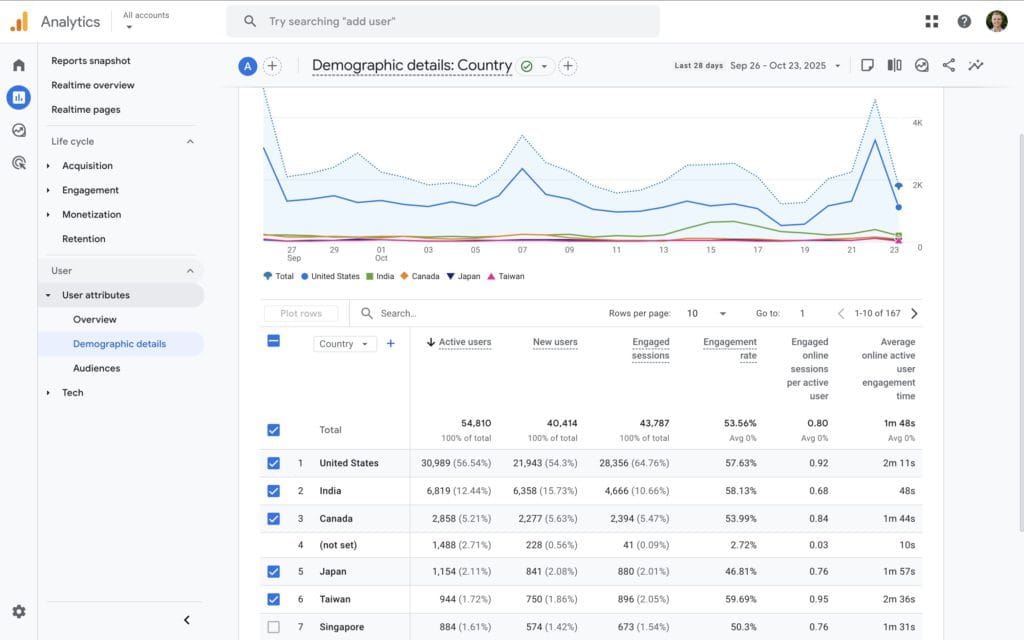
Effective Strategies Based on Demographic Insights:
- Personalize Your Content: Develop content and marketing messages that align seamlessly with the preferences of your primary demographic segments.
- Implement Targeted Advertising: Utilize demographic data to refine your ad targeting, ensuring your promotions reach the most receptive audience.
- Expand Your Market Reach: Identify underrepresented demographics that present growth opportunities and strategize to engage these potential users.
By focusing on demographic insights, you can design marketing campaigns that are more relevant and effective, connecting with your audience’s specific needs and preferences.
5. Monetization Report: Gain Valuable Insights into Your Revenue Streams
For websites generating revenue, the Monetization reports are indispensable. These reports provide a comprehensive overview of how users contribute to your financial success, enabling you to make strategic decisions based on data.
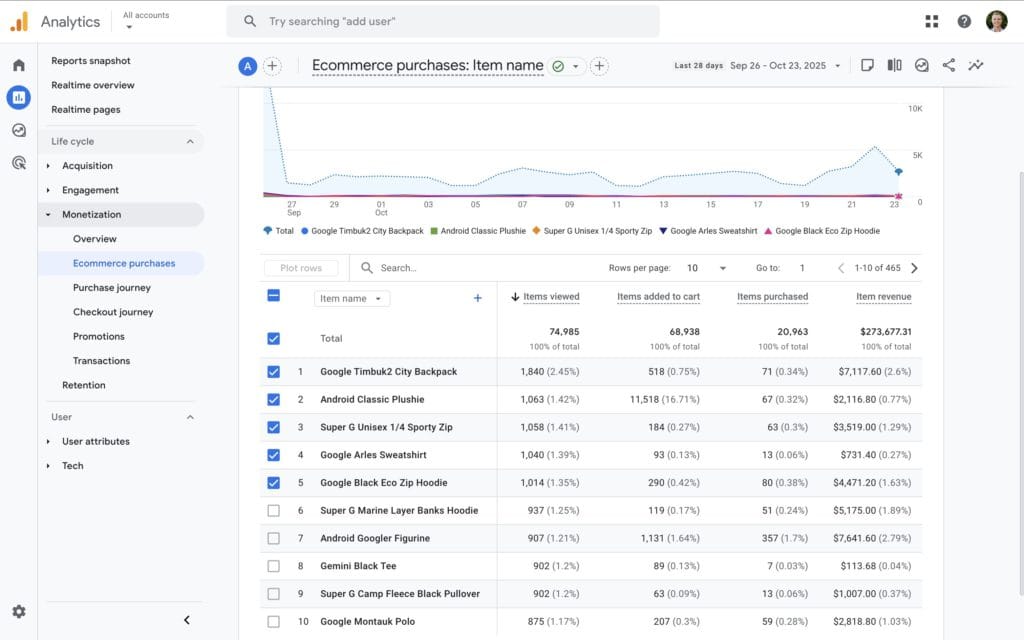
Essential Metrics to Monitor for Financial Success:
- Total Revenue: The cumulative income generated over a specified period, providing a clear snapshot of financial performance.
- Average Purchase Revenue: The average revenue generated per transaction, aiding in assessing profitability.
- Purchases: Track the frequency and types of products or services sold to better understand customer preferences.
Utilize This Data to Boost Your Revenue:
- Identify Your Best-Selling Products: Direct your marketing efforts towards products that generate the highest revenue.
- Enhance Product Promotion: Increase the visibility and appeal of your products to drive sales and revenue.
- Leverage Upselling and Cross-Selling Opportunities: Utilize purchasing data to suggest complementary products, thereby boosting the average order value.
A comprehensive understanding of your monetization metrics empowers you to make informed decisions that enhance your profitability and overall business growth.
Take Action Now to Master Google Analytics
By familiarizing yourself with these five pivotal GA4 reports, you are establishing the foundation for marketing success driven by data-informed insights. Once you are prepared to deepen your expertise in Google Analytics, consider enrolling in a Google Analytics 4 Course to learn how to effectively leverage these reports and maximize this essential business tool.
Remember that successful marketing is not solely about attracting visitors; it is equally about understanding their needs and behaviors. Utilize the reports discussed here to gain deeper insights into your audience, refine your strategies, and watch your marketing initiatives flourish.
The post 5 Google Analytics Reports Every Marketer Should Know About appeared first on Ezi Gold.
The Article Essential Google Analytics Reports Every Marketer Needs Was Found On https://limitsofstrategy.com


